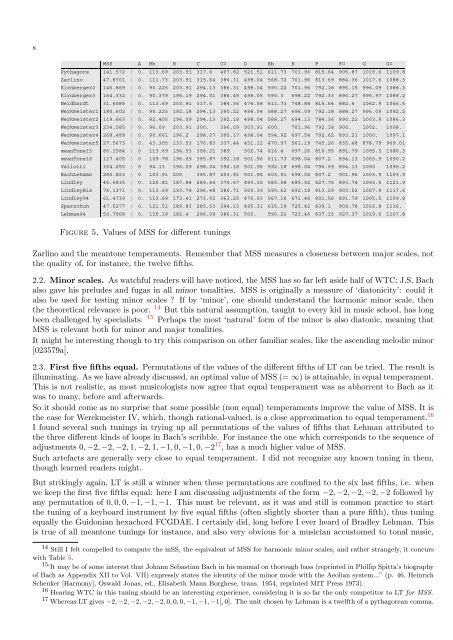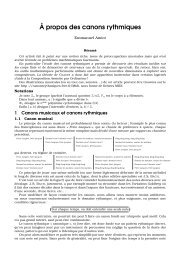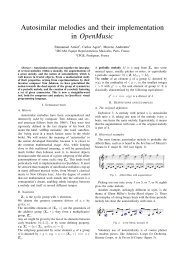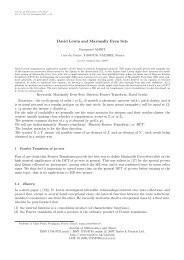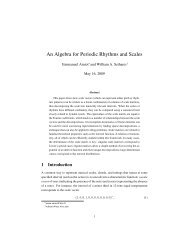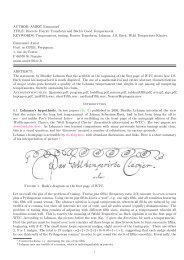Emmanuel Amiot Modèles algébriques et algorithmes pour la ...
Emmanuel Amiot Modèles algébriques et algorithmes pour la ...
Emmanuel Amiot Modèles algébriques et algorithmes pour la ...
You also want an ePaper? Increase the reach of your titles
YUMPU automatically turns print PDFs into web optimized ePapers that Google loves.
8<br />
MSS A Bb B C C D Eb E F F G G<br />
Pythagore 141.572 0. 113.69 203.91 317.6 407.82 521.51 611.73 701.96 815.64 905.87 1019.6 1109.8<br />
Zarlino 47.8701 0. 111.73 203.91 315.64 386.31 498.04 568.72 701.96 813.69 884.36 1017.6 1088.3<br />
Kirnberger2 146.869 0. 90.225 203.91 294.13 386.31 498.04 590.22 701.96 792.18 895.15 996.09 1088.3<br />
Kirnberger3 164.332 0. 90.379 195.19 294.01 386.45 498.05 590.3 698.22 792.33 890.27 995.97 1088.2<br />
Neidhardt 31.6585 0. 113.69 203.91 317.6 384.36 474.58 611.73 748.88 815.64 882.4 1062.9 1066.5<br />
Werkmeister1 180.602 0. 90.225 192.18 294.13 390.22 498.04 588.27 696.09 792.18 888.27 996.09 1092.2<br />
Werkmeister2 119.663 0. 82.405 196.09 294.13 392.18 498.04 588.27 694.13 784.36 890.22 1003.9 1086.3<br />
Werkmeister3 234.585 0. 96.09 203.91 300. 396.09 503.91 600. 701.96 792.18 900. 1002. 1098.<br />
Werkmeister4 268.489 0. 90.661 196.2 298.07 395.17 498.04 594.92 697.54 792.62 893.21 1000. 1097.1<br />
Werkmeister5 27.5673 0. 43.305 133.53 176.83 337.44 451.12 470.97 561.19 745.26 835.48 878.79 969.01<br />
meanTone15 80.1584 0 113.69 194.53 308.21 389 502.74 616.4 697.26 810.95 891.79 1005.5 1086.3<br />
meanTone16 117.405 0 109.78 196.09 305.87 392.18 501.96 611.73 698.04 807.2 894.13 1003.9 1090.2<br />
Vallotti 164.255 0 94.13 196.09 298.04 392.18 501.96 592.18 698.04 796.09 894.13 1000 1090.2<br />
BachLehman 266.823 0 103.91 200 305.87 403.91 501.96 603.91 698.04 807.2 901.96 1003.9 1103.9<br />
Lindley 45.6815 0. 125.81 187.88 289.44 379.67 493.35 583.58 685.92 827.76 893.74 1003.5 1121.9<br />
LindleyBis 76.1371 0. 113.69 193.74 296.48 386.71 500.39 590.62 692.18 813.29 903.52 1027.4 1117.6<br />
Lindley94 61.4739 0. 113.69 173.41 273.02 363.25 476.93 567.16 671.46 801.56 891.79 1005.5 1109.8<br />
Sparschuh 47.5277 0. 121.51 189.83 285.53 394.13 495.31 635.19 725.42 839.1 909.78 1016.8 1116.<br />
Lehman94 50.7568 0. 135.19 182.4 296.09 386.31 500. 590.22 723.46 837.15 927.37 1019.6 1107.8<br />
Figure 5. Values of MSS for different tunings<br />
Zarlino and the meantone temperaments. Remember that MSS measures a closeness b<strong>et</strong>ween major scales, not<br />
the quality of, for instance, the twelve fifths.<br />
2.2. Minor scales. As watchful readers will have noticed, the MSS has so far left aside half of WTC: J.S. Bach<br />
also gave his preludes and fugas in all minor tonalities. MSS is originally a measure of ‘diatonicity’: could it<br />
also be used for testing minor scales ? If by ‘minor’, one should understand the harmonic minor scale, then<br />
the theor<strong>et</strong>ical relevance is poor. 14 But this natural assumption, taught to every kid in music school, has long<br />
been challenged by specialists. 15 Perhaps the most ‘natural’ form of the minor is also diatonic, meaning that<br />
MSS is relevant both for minor and major tonalities.<br />
It might be interesting though to try this comparison on other familiar scales, like the ascending melodic minor<br />
[023579a].<br />
2.3. First five fifths equal. Permutations of the values of the different fifths of LT can be tried. The result is<br />
illuminating. As we have already discussed, an optimal value of MSS (= ∞) is attainable, in equal temperament.<br />
This is not realistic, as most musicologists now agree that equal temperament was as abhorrent to Bach as it<br />
was to many, before and afterwards.<br />
So it should come as no surprise that some possible (non equal) temperaments improve the value of MSS. It is<br />
the case for Werckmeister IV, which, though rational-valued, is a close approximation to equal temperament. 16<br />
I found several such tunings in trying up all permutations of the values of fifths that Lehman attributed to<br />
the three different kinds of loops in Bach’s scribble. For instance the one which corresponds to the sequence of<br />
adjustments 0, −2, −2, −2, 1, −2, 1, −1, 0, −1, 0, −2 17 , has a much higher value of MSS.<br />
Such artefacts are generally very close to equal temperament. I did not recognize any known tuning in them,<br />
though learned readers might.<br />
But strikingly again, LT is still a winner when these permutations are confined to the six <strong>la</strong>st fifths, i.e. when<br />
we keep the first five fifths equal: here I am discussing adjustments of the form −2, −2, −2, −2, −2 followed by<br />
any permutation of 0, 0, 0, −1, −1, −1. This must be relevant, as it was and still is common practice to start<br />
the tuning of a keyboard instrument by five equal fifths (often slightly shorter than a pure fifth), thus tuning<br />
equally the Guidonian hexachord FCGDAE. I certainly did, long before I ever heard of Bradley Lehman. This<br />
is true of all meantone tunings for instance, and also very obvious for a musician accustomed to tonal music,<br />
14 Still I felt compelled to compute the mSS, the equivalent of MSS for harmonic minor scales, and rather strangely, it concurs<br />
with Table 5.<br />
15 ‘It may be of some interest that Johann Sebastian Bach in his manual on thorough bass (reprinted in Phillip Spitta’s biography<br />
of Bach as Appendix XII to Vol. VII) expressly states the identity of the minor mode with the Aeolian system...” (p. 46, Heinrich<br />
Schenker [Harmony], Oswald Jonas, ed., Elisab<strong>et</strong>h Mann Borghese, trans. 1954, reprinted MIT Press 1973).<br />
16 Hearing WTC in this tuning should be an interesting experience, considering it is so far the only comp<strong>et</strong>itor to LT for MSS.<br />
17 Whereas LT gives −2, −2, −2, −2, −2, 0, 0, 0, −1, −1, −1[, 0]. The unit chosen by Lehman is a twelfth of a pythagorean comma.


